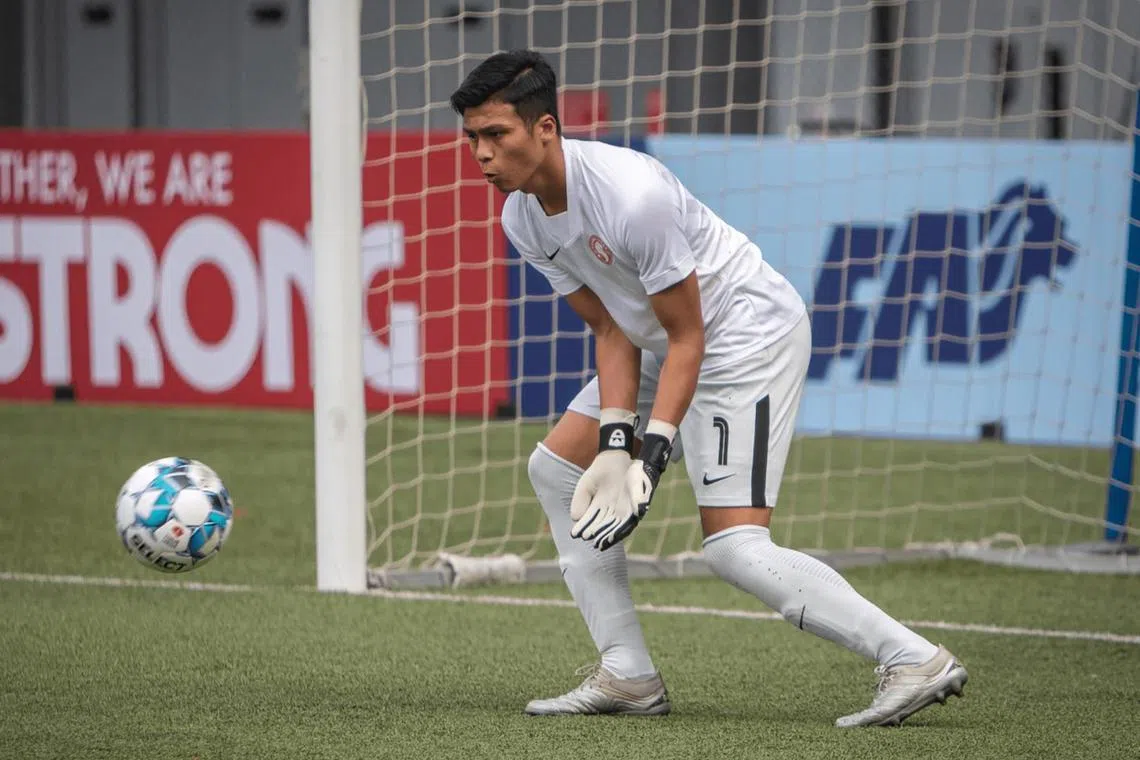Singapore Sports School student’s death: Congenital heart issues not so easy to detect, say experts
Sign up now: Get ST's newsletters delivered to your inbox

This comes in light of the Singapore sports school student, Pranav Madhaik, who died recently on Oct 11.
PHOTO: ST FILE
Follow topic:
SINGAPORE – At 22, Nurshafiq Zaini was in the pink of health and living his dream.
The Young Lions goalkeeper, who was competing in the Singapore Premier League (SPL), had already represented Singapore at every age group at the youth level and was eyeing a spot in the national team.
But in 2021, his world came crashing down. A pre-national service (NS) enlistment medical screening found that Nurshafiq had an anomalous origin of coronary artery, a congenital abnormality that may affect the size and shape of arteries that supply blood to the heart.
Doctors told him that he could suffer cardiac arrest during vigorous activity and advised that he stop all high-intensity sports and activities.
Nurshafiq was eventually exempted from NS and he retired from professional football. He was devastated and, for weeks, he cried himself to sleep.
Nurshafiq, who made 15 appearances in the SPL, said: “I never had any issues. No symptoms and no problems. I had even been an outfield player in secondary school and training sessions at my previous clubs and at Young Lions were tough.
“But suddenly I had to live with the fact that I had this heart issue.”

Goalkeeper Nurshafiq Zaini in action for the Young Lions in the Singapore Premier League.
PHOTO: SINGAPORE PREMIER LEAGUE
The issue of high-intensity sports and health-related concerns has been in the spotlight recently after the local fraternity suffered a tragedy on Oct 11, when Singapore Sports School (SSP) student Pranav Madhaik, 14, died after a fitness test.
The SSP badminton academy student had felt unwell after completing a 400m fitness time trial on Oct 5 and was then taken to hospital, where he died six days later. The cause of death was cardiac arrest with antecedent cause of congenital malformation of coronary vessels.
The Sunday Times understands that the congenital condition was not detected during a mandatory pre-admission test that all SSP students are required to undergo.
The medical examination includes tests of the cardiovascular system, pulmonary system, neurology assessment, musculoskeletal examination, and laboratory tests such as urinalysis, full blood count, ECG and chest X-ray. Students must be certified fit for physical training by a sports doctor.
Pranav’s death has caused concern among parents, who may be worried about their children participating in sporting activities. Some have also questioned if they should subject their kids to more stringent health checks and tests beforehand.
Not so easy to detect
According to medical experts whom ST consulted, while some congenital issues can be detected during medical examinations, there is no guarantee.
Dr Yeo Tee Joo, a senior consultant at the department of cardiology in the National University Heart Centre, Singapore, said: “Congenital cardiac issues are a very broad spectrum and much depends on the specific type.
“Certain inherited conditions which are structural (such as hypertrophic cardiomyopathy) or electrical (like brugada syndrome) in nature may potentially be picked up by an ECG screening. However, there will be some which are not readily detected on screening.
“An ECG primarily looks for underlying rhythm issues and are not specifically used for the diagnosis of congenital structural abnormalities. The standard ECG is also done at rest, and not during exertion.”
In professional sport, there have been footballers who had such conditions uncovered only later in their careers.
At Euro 2020, Inter Milan midfielder Christian Eriksen collapsed during Denmark’s opening game against Finland. He suffered a cardiac arrest but survived after receiving life-saving treatment on the pitch.
The 31-year-old, who now plays for Manchester United, had no history of heart concerns and had returned normal tests from 2013 to 2019.
His collapse came nine years after Fabrice Muamba’s near-fatal incident, in which he suffered a heart attack and collapsed during the FA Cup quarter-final between Bolton and Tottenham Hotspur.
In October 2022, Brighton midfielder Enock Mwepu was also forced to retire at the age of 24 because of a hereditary heart condition.
Are more stringent checks needed?
Asst Prof Koh Choong Hou, a consultant at the department of cardiology, National Heart Centre Singapore, told ST: “Understandably, most parents will be concerned after reading about the news of seemingly healthy young athletes collapsing during sports activities.
“However, it is important to note that low to moderate-intensity sports offer substantial long-term health benefits and typically do not require any specific medical checks, unless the child experiences unusual exertional related symptoms.”
Such symptoms include severe chest discomfort, breathlessness, fainting spells or palpitations, he added, and they should undergo a medical evaluation before more intensive training or sports.
When asked if schools need to conduct more health checks for student-athletes, or if parents should do so, Dr Cormac O’Muircheartaigh, medical director at the Sports Medicine Lab, noted that “pre-participation medical screening” is a “very good recommendation for athletes beginning a training programme”.
However, it will come at extra cost. He said: “For each level of screening, there would be an increase in associated costs. For example, an ECG may cost $20 per athlete, but an echocardiogram may cost $300 per athlete and a CT angiogram may cost more than $1,000 per athlete.
“If the initial first-line step is performed well, the indication for second- or third-line investigations and treatments are low.”
There is also the question of which party is responsible for organising the checks, he added.
Lessons from tragedy
Three days after Pranav’s death, the SSP sacked a badminton coach as investigations found that the coach should have checked on the student to ensure his well-being before leaving the track.
He also did not account for all his student-athletes before dismissing them from training, which was not in accordance with the school’s safety protocols.
Dr O’Muircheartaigh urged coaches and teachers to be more vigilant and ensure that they have Standard First Aid certification.
He added: “It’s pretty common to have breathlessness during exercise. But most of the time within 30 seconds or maximum minutes, most breathlessness will be relieved by rest.
“So if someone is still feeling unwell and breathless after a minute, and especially if they have any other symptoms like fatigue or chest pain, chest tightness or palpitations, they are concerning signs. In that situation, a coach should seek help and call for an ambulance.”
Today, Nurshafiq is a bus mechanic with SBS Transit while pursuing a diploma in mechanical engineering at Ngee Ann Polytechnic.
While he was initially distraught when his football dream was dashed, the 24-year-old is now thankful that his condition was discovered early.
He said: “It took me a year to understand why this happened to me before I realised that I should thank God that this was detected earlier. I loved football more than anything but health comes first.”


